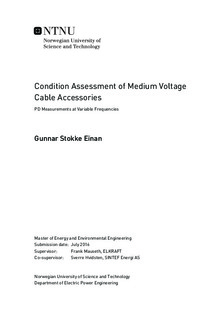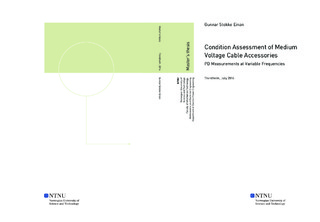| dc.description.abstract | Diagnostic PD testing of medium voltage cables can be performed at very low frequencies (VLF, 0.1 Hz), to reduce capacitive currents. At 0.1 Hz the field distribution in the field grading materials is likely different from the one at power frequency, possibly leading to wrong conclusions from the tests. The frequency dependency of such materials, can be investigated using previously tested PD sources, where different PD parameters have been characterised as function of frequency. In this work, it was tested if hollow glass microspheres were suited as such a PD source.
The spheres were molded into a silicone cup and tested under a uniform field. Before each test, the test object was electrical conditioned for 16.5 hours either at 6 kV at 50 Hz or at ground potential to have equal initial conditions. The PD inception and extinction voltage were tested as indicators of the field strength at the site of the spheres. These parameters were, among others, found for selected frequencies in the range from 0.1 to 50 Hz. The data was recorded during the tests and later analysed with PRPD-, Weibull- and pulse sequence analysis. A finite element simulation was performed to find the relation between the applied voltage and the field strength inside the glass sphere.
The tests showed a great dependency on the initial condition, with a higher PD inception voltage after a period of grounding. This showed the importance of an equal initial condition and a standardized conditioning period before each test. The inception voltage varied a bit, but the extinction voltage was more consistent and found to be a good parameter for determining the field strength inside the spheres.The cavity discharges gave characteristic and easily recognizable patterns in the PRPD-analysis, the shape parameters in the Weibull distributions were consistent with the literature and the pulse sequence analysis confirmed the earlier findings and could also reveal periods without discharges. The start electron availability decreased during a long period of many test series, causing the discharge characteristics to change, but still being consistent with cavity discharges. A relation between the applied voltage and the field strength inside the spheres was found through the FEM simulations and the decrease in the repetition rate with decreasing voltage.
Based on these findings, the spheres can be suited for testing, if the start electron availability reaches a steady state. The PD extinction voltage is a reliable parameter suited for determining the field strength at the site of the sphere. | |

